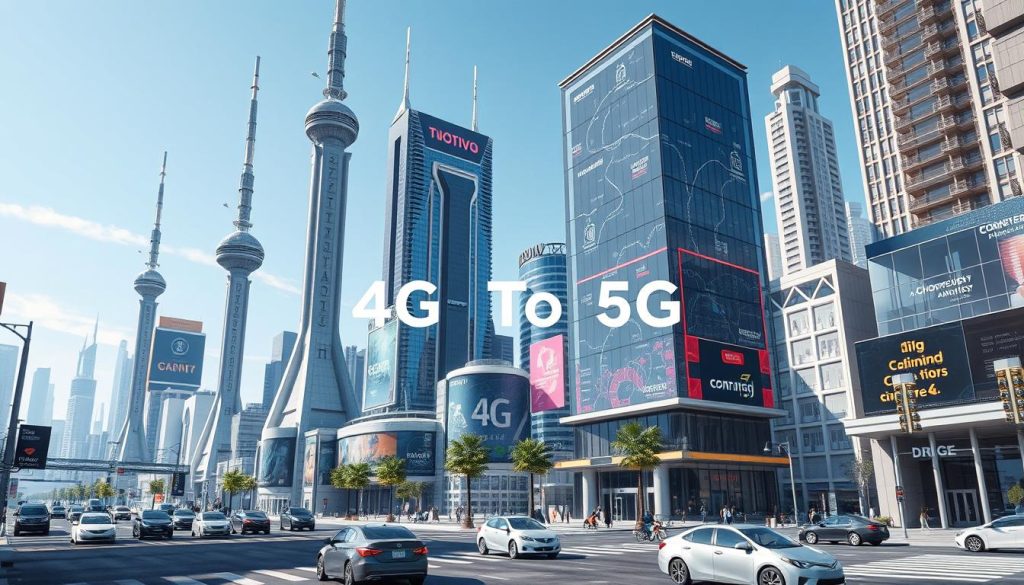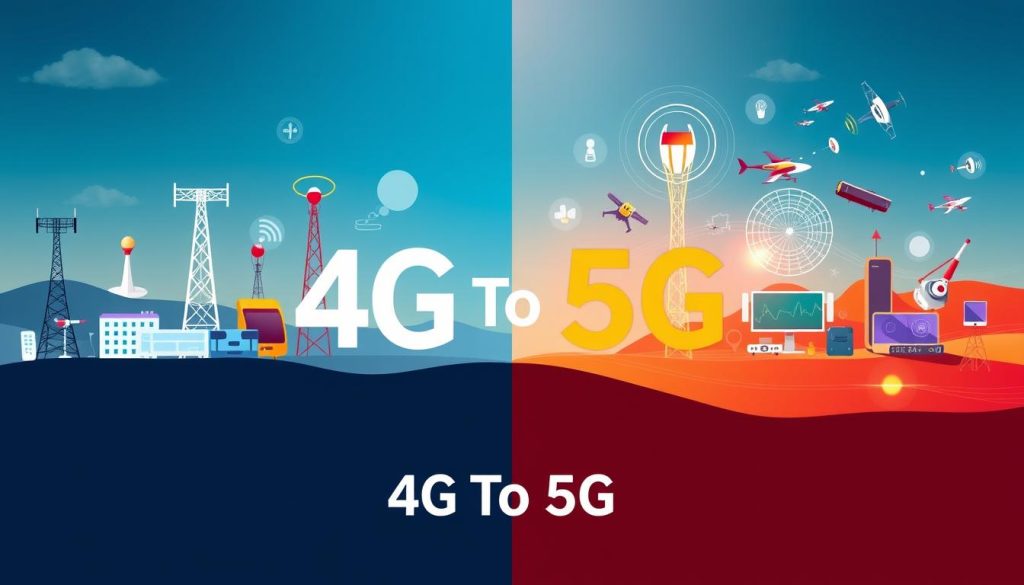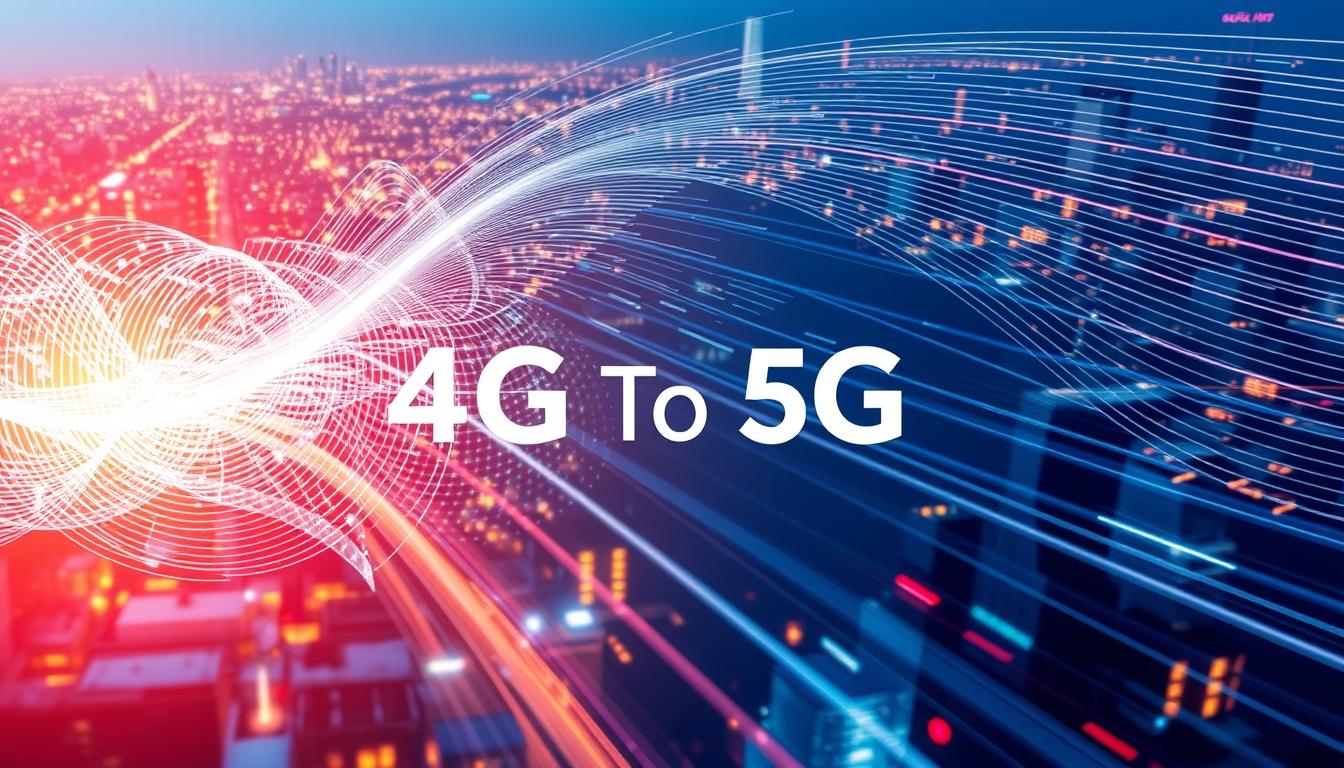Thinking about moving from 4G to 5G? It’s essential to understand the major benefits this upgrade brings. 5G technology offers unmatched speed and better connectivity, changing how we use digital services. You’ll enjoy faster data transfer, smoother video streaming, and more immersive gaming. This article will guide you through the advantages, challenges, and how to make the switch. It aims to ensure your 4G to 5G upgrade is seamless and meets your requirements.
Key Takeaways
- Understanding the importance of upgrading to 5G.
- Exploring enhanced speed and connectivity options.
- Recognizing the significance of low latency benefits.
- Assessing network capacity advantages offered by 5G.
- Ensuring your devices are compatible for a smooth transition.
- Identifying the right 5G provider for your needs.
Understanding the Advantages of 5G Technology
The shift to 5G technology introduces significant benefits, transforming connectivity and user experience. It offers improved network speed and enhanced connectivity, leading to numerous advantages.
Enhanced Speed and Connectivity
Switching to 5G brings enhanced speed and connectivity as immediate benefits. It enables quicker download and upload times, often reaching several gigabits per second. Streaming high-definition videos or transferring large files becomes effortless, making your digital life smoother and more enjoyable.
Low Latency Benefits
5G technology also offers low latency benefits. It ensures near-instant communication between devices, vital for real-time applications. Innovations like augmented reality experiences or remote surgery rely on minimal delay. With 5G, these possibilities become a reality.
Increased Network Capacity
As more devices connect, having a network that can handle the demand is essential. 5G addresses this with increased network capacity. This improvement offers flexibility and reliability in various settings, from smart homes to industrial environments. You no longer face network congestion during peak times, ensuring a seamless online experience.

4G vs 5G: Key Differences
Exploring the differences between 4G and 5G expands your understanding of mobile technology and its evolution. A comparison between 4G and 5G highlights significant variations in performance metrics and the necessary upgrades in technology infrastructure.
Performance Metrics Comparison
The metrics for 4G and 5G show a significant leap forward with 5G. While 4G networks offer speeds up to 100 Mbps, 5G can reach speeds between 1 Gbps and 10 Gbps. This enhancement allows for faster downloads, smoother streaming, and reduced lag in gaming. It also supports a much larger number of devices per square kilometer, ensuring seamless connectivity in densely populated areas.
Technology Infrastructure Changes
The shift from 4G to 5G requires significant updates in technology infrastructure. 5G networks are built on a denser network of antennas, including small cells in urban settings. This setup boosts both coverage and data speeds. The use of higher-frequency bands also increases capacity and reduces latency, albeit at the cost of a shorter range compared to 4G signals.

| Feature | 4G | 5G |
|---|---|---|
| Maximum Speed | Up to 100 Mbps | 1-10 Gbps |
| Devices Supported per km² | Approximately 2,000 | Up to 1 million |
| Latency | 30-50 ms | 1 ms |
| Network Architecture | Macrocell Based | Small Cell and Macrocell Combination |
Steps to Successfully Transition from 4G to 5G
Transitioning from 4G to 5G requires a series of steps to ensure a smooth upgrade. With the rapid evolution of mobile technology, your experience can greatly enhance with the right actions. Begin by assessing your current network capabilities, ensuring your devices are compatible, and selecting a reliable network provider.
Assessing Your Current Network
First, evaluate your existing network. Determine if it meets the criteria for 5G compatibility. This initial step will reveal if your current infrastructure needs upgrades or adjustments for the transition.
Checking Device Compatibility
Verify if your devices support the new 5G technology. Many older smartphones and laptops lack the necessary hardware for 5G, requiring an upgrade. Always check manufacturer specifications for confirmation.
Finding the Right 5G Provider
Securing a dependable 5G network provider is key for a seamless transition. Consider factors like coverage areas, available speed plans, and customer service ratings. Research various options to find the best provider for your needs.
| Provider | Coverage Area | Speed Plans | Customer Service Rating |
|---|---|---|---|
| Reliance Jio | Pan India | Up to 1 Gbps | 4.5/5 |
| Airtel | Metropolitan Cities | Up to 500 Mbps | 4.2/5 |
| Vi | Selected Urban Areas | Up to 300 Mbps | 4.0/5 |
4G to 5G Convert: What You Need to Know
The shift from 4G to 5G is a significant leap forward for both users and businesses. It’s essential to grasp the intricacies of the 5G conversion process for a smooth transition. This evolution encompasses more than just technological advancements. It also requires strategic planning for enhanced performance and new features.
The Conversion Process Explained
Understanding the key steps in the 4G to 5G migration is vital. Start by assessing your current infrastructure to pinpoint necessary upgrades. Reach out to your telecom provider to learn about their 5G conversion steps. This ensures you’re well-informed about service availability and rollout schedules. Such preparation allows you to capitalize on the benefits as soon as they’re available.
Preparing for the Change
Preparing for the transition involves reviewing your equipment and service requirements. Check if your devices are compatible with 5G, as many older models may not support it. Learn about the new features of 5G, like faster speeds and lower latency, to make better device choices. Also, involve your team in the process to ensure everyone is on the same page with this new technology.
Benefits of Transitioning to 5G Technology
Adopting 5G technology can transform your connectivity experience. This move not only boosts your daily interactions but also keeps your network competitive. Recognizing the advantages of switching to 5G is key. It significantly enhances functionality and fosters innovation.
Future-Proofing Your Connection
Choosing 5G technology ensures you stay at the forefront of digital communication. It offers speeds that are both fast and reliable. This supports the latest applications, from augmented reality to smooth video calls. Your connection will grow with new technologies, preventing it from becoming outdated.
Improved User Experience
The shift to 5G greatly enhances your user experience. Faster speeds mean streaming and gaming are more seamless. Latency drops, making real-time communication and collaboration more efficient. By opting for 5G, you’re investing in a future where connectivity enriches your life, whether for work or play.
| Feature | 4G Technology | 5G Technology |
|---|---|---|
| Speed | Up to 1 Gbps | Up to 20 Gbps |
| Latency | 30-50 ms | 1 ms |
| Network Capacity | 1,000 devices/km² | 1 million devices/km² |
| Applications | Mobile streaming | IoT, AR, VR applications |
Real-World Applications of 5G Networks
Exploring the real-world applications of 5G reveals its vast impact on daily life and operations. This technology is more than just an upgrade; it marks a significant transformation. It’s most evident in smart cities, healthcare, and transportation.
Smart Cities and IoT
In smart cities, 5G serves as the foundation for interconnected infrastructure. It enables faster, more reliable connectivity, optimizing various city aspects. Traffic management systems benefit from real-time data, improving flow and reducing congestion.
Energy usage is also regulated effectively, promoting sustainability through smart grids. These innovations showcase how 5G networks can elevate urban living in smart cities.
Impact on Industries: Healthcare and Transportation
The impact on industries, like healthcare and transportation, is significant. 5G enhances telemedicine, allowing for high-definition video consultations and real-time patient monitoring. This ensures timely interventions and improves care quality.
In transportation, real-time data informs logistics operations, boosting efficiency and traffic flow. This technology will eventually enable autonomous vehicles, transforming travel.
| Feature | Smart Cities | Healthcare | Transportation |
|---|---|---|---|
| Real-Time Data Usage | Optimizes traffic and energy | Enhances telemedicine | Improves logistics efficiency |
| Infrastructure Connectivity | Interconnected urban services | Remote patient monitoring | Supports autonomous vehicles |
| Sustainability Efforts | Reduces carbon footprint | Immediate access to healthcare | Streamlined transportation networks |
Navigating the Smart Transition to 5G
Switching to 5G technology is both thrilling and daunting. To make this transition smooth, adopting certain strategies is key. Knowing what to expect and understanding common pitfalls can greatly enhance your experience. By familiarizing yourself with essential 5G transition tips, you can ensure a seamless migration to 5G.
Tips for a Smooth Migration
- Create a detailed migration plan that outlines timelines and possible obstacles.
- Work closely with your service provider for effective communication.
- Take stock of your current devices to ensure they’re compatible with 5G networks.
What to Expect During the Upgrade
Preparing for the transition is essential. Expect some downtime during the upgrade process. Your service provider should keep you updated on any scheduled maintenance or upgrades. This way, you can avoid service disruptions and enjoy a positive experience.
Common Pitfalls to Avoid
- Don’t assume all devices are compatible with 5G; always check.
- Don’t overlook educating employees or users on the new systems and features.
- Remember, you may need updated infrastructure to support 5G capabilities.
Exploring Next-Generation 5G Deployment Strategies
The world of telecommunications is rapidly changing, making 5G deployment strategies more critical than ever. To implement networks successfully, a customized approach is necessary. This involves strategic placement of infrastructure, efficient bandwidth use, and working closely with local authorities and industries.
New technologies open up exciting possibilities for 5G. For example, network slicing allows for dedicated channels within the network. This optimizes resource use for different applications, improving performance and efficiency. Edge computing also plays a key role by processing data closer to users, reducing latency and boosting service quality.
As 5G adoption grows, staying updated on new trends is vital. Keeping abreast of technological advancements ensures your network benefits fully from 5G’s capabilities. This approach makes your network implementation both effective and adaptable to future needs.
Conclusion
Switching from 4G to 5G marks a significant leap in connectivity, meeting your evolving tech needs. The 5G network offers speeds, latency, and capacity that 4G can’t match. These improvements will transform your personal and professional life, making communication, online interactions, and device use more efficient.
By making this upgrade, you’re not just getting new tech; you’re leading the charge in a more connected world. The advantages of 5G go beyond today’s benefits, preparing you for future needs.
To make the most of this transition, focus on planning, preparation, and learning about this digital leap. This approach will help you fully experience the benefits of 5G. Your journey to better connectivity and innovation has begun.
FAQ
What are the main benefits of upgrading to 5G?
Upgrading to 5G technology brings significant advantages. It offers faster speeds and better connectivity, making real-time applications possible. It also supports more devices, improving streaming, gaming, and productivity across various industries.
How can I check if my device is compatible with 5G?
To see if your device supports 5G, visit your manufacturer’s website or check with your service provider. Most recent smartphones are 5G-ready. But, older models might need upgrades to use the new tech.
What steps should I take to transition from 4G to 5G seamlessly?
For a smooth 4G to 5G switch, first, check your network and device compatibility. Then, find a 5G provider with coverage in your area. Lastly, prepare your devices and consider upgrades to enjoy 5G’s full benefits.
Will I experience any downtime during the switch to 5G?
Some downtime might happen when switching to 5G. But, with proper planning and your provider’s help, you can minimize disruptions. Try to switch during off-peak times to reduce connectivity issues.
What common pitfalls should I avoid when upgrading to 5G?
When upgrading to 5G, avoid assuming all devices will work with the new network. Don’t overlook training users on new features and assess your coverage needs correctly. Being informed and organized helps you avoid these common mistakes.
How does the performance of 4G compare to 5G?
5G outperforms 4G by a significant margin. It offers speeds ten to a hundred times faster, making data transfer more efficient. This supports more devices at once, ideal for high-bandwidth activities like HD streaming and gaming.
What real-world applications benefit from 5G technology?
5G technology enhances various applications, like smart cities’ infrastructure. It also boosts healthcare with high-definition telemedicine and transportation with real-time data for better logistics and traffic management.
What is involved in the 4G to 5G conversion process?
The 4G to 5G conversion requires careful planning. This includes upgrading devices and learning about new 5G features. It also means ensuring your network can handle the latest standards.
How can I prepare for upgrading to a 5G network?
To prepare for a 5G upgrade, assess your current equipment and check device compatibility. Choose a reliable provider and learn about 5G’s new features. This preparation helps you maximize 5G’s benefits.
What are some tips for ensuring a smooth 5G migration?
For a smooth 5G migration, create a detailed plan with timelines. Keep in touch with your service provider and train users on new systems. Anticipating challenges and preparing well can make the transition smoother.
